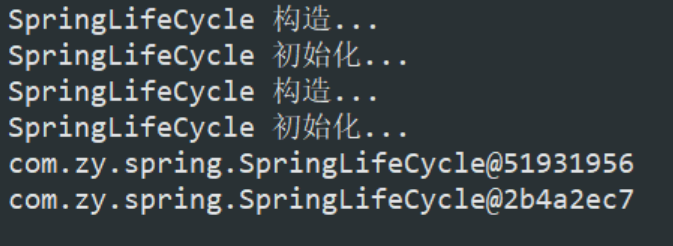首先我们要了解注解和xml配置的区别:
作用一样,但是注解写在Bean的上方来代替我们之前在xml文件中所做的bean配置,也就是说我们使用了注解的方式,就不用再xml里面进行配置了,相对来说注解方式更为简便。
IOC获取对象注解方式:
在我们第二篇(IOC容器配置 xml方式)总结的基础上做修改:
首先我们的applicationContext.xml配置文件要略作修改:(把beans里面加上绿色背景的配置)
<?xml version="1.0" encoding="UTF-8"?> <beans xmlns="http://www.springframework.org/schema/beans" xmlns:context="http://www.springframework.org/schema/context" xmlns:xsi="http://www.w3.org/2001/XMLSchema-instance" xsi:schemaLocation=" http://www.springframework.org/schema/beans http://www.springframework.org/schema/beans/spring-beans.xsd http://www.springframework.org/schema/context http://www.springframework.org/schema/context/spring-context.xsd "> <!--开启扫描 扫描包com.zy下面的--> <context:component-scan base-package="com.zy"></context:component-scan> </beans>
然后我们的JavaBean类加上注解(Component):
@Component("bean1")
public class Bean1 {
public Bean1() {
System.out.println("Bean1的无参构造方法");
}
}
这样就代替了我们之前在applicationContext.xml中配置的: <bean id="bean1" class="com.zy.IoC.Bean1"></bean>
测试及运行结果请参照总结第二篇,得出的结果是一样的。
-
@Repository 用于注册DAO(持久层 )
-
@Service 用于注册 Service(业务层)
-
@Controller 用于注册 Action (表现层)
以@Repository为例:
/** * 测试UserDao接口 */ public interface UserDao { public void getUser(); } /** * UserDao实现类1 */ @Repository("userDao") public class UserDaoImpl implements UserDao { public UserDaoImpl() { System.out.println("dao1 构造方法"); } @Override public void getUser() { System.out.println("UserDao实现类1 获取用户信息..."); } }
测试:
@Test public void getUser() throws Exception { //根据spring配置文件 获取spring容器 ApplicationContext ac = new ClassPathXmlApplicationContext("applicationContext.xml"); //使用容器创建UserDao的实现类对象 userDao和配置文件中的 bean的id一致 UserDao dao = ac.getBean("userDao", UserDao.class); dao.getUser(); }
运行结果:

DI依赖注入注解方式:
注解基本类型属性:这个不多做介绍了
// 基本类型属性 @Value("#{'张学友'}") private String name;
注解复杂类型属性:
1,Spring3.0提供@Value注解
// 复杂类型属性 // 第一种 @Value 结合 spEL @Value("#{userDao}") private UserDao userDao;
2,Spring2.0 提供@Autowired 注解 结合 @Qualifier 注解
// 第二种 @Autowired 注解 结合 @Qualifier 注解 // 如果单独使用@Autowired 默认按照类型注入,如果有多个同一类型的只能找到一个 // 使用 @Qualifier 按照名称注入 @Autowired @Qualifier("userDao") private UserDao userDao;
3,JSR-250规范 提供 @Resource 注解实现注入(不推荐使用)
// 第三种 JSR-250提供@Resource 注解 // 不写name属性,按照类型注入,写了name属性,按照名称注入 @Resource(name = "userDao") private UserDao userDao;
以把UserDao注入到UserService为例:
JavaBean代码:
/** * 测试UserDao接口 */ public interface UserDao { public void getUser(); } /** * UserDao实现类1 */ @Repository("userDao") public class UserDaoImpl implements UserDao { @Override public void getUser() { System.out.println("2 UserDao实现类1 获取用户信息..."); } } /** * UserService接口 */ public interface UserService { public void getUser(); } /** * UserService实现类 */ @Service("userService") public class UserServiceImpl implements UserService { //@Autowired+@Qualifier的方式 //@Autowired //@Qualifier("userDao") @value("#{userDao}") //@Value("#{}")的方式 使用注解注入,要与dao实现类的注解一致(使用注解 不需要setter方法, 如果没有构造方法,使用xml配置的时候需要setter方法) private UserDao userDao; @Override public void getUser() { System.out.println("1 业务层1 获取user对象..."); userDao.getUser(); } }
测试:
@Test public void getUser() throws Exception { ApplicationContext ac = new ClassPathXmlApplicationContext("applicationContext.xml"); UserService userService = ac.getBean("userService", UserService.class); userService.getUser(); }
运行结果:

其他注解的使用:
生命周期注解:
@PostConstruct 初始化方法
@PreDestroy 销毁方法
//Bean的注解 @Component("springLifeCycle") public class SpringLifeCycle { //构造方法 public SpringLifeCycle() { System.out.println("SpringLifeCycle 构造..."); } //初始化方法的注解 @PostConstruct public void init() { System.out.println("SpringLifeCycle 初始化..."); } //销毁方法的注解 @PreDestroy public void destroy() { System.out.println("SpringLifeCycle 销毁..."); } public void helloSpring() { System.out.println("hello spring !"); } }
测试:
@Test public void testLifeCycle() { ApplicationContext ac = new ClassPathXmlApplicationContext( "applicationContext.xml"); SpringLifeCycle springLifeCycle = (SpringLifeCycle) ac.getBean("springLifeCycle"); springLifeCycle.helloSpring(); // 调用close(ApplicationContext没有close方法,需要转子类调用close) ClassPathXmlApplicationContext classAc = (ClassPathXmlApplicationContext) ac; classAc.close(); }
运行结果:

Bean的作用域注解:
还是上面的JavaBean类:
//Bean的注解 @Component("springLifeCycle") //作用域注解 prototype为多实例,默认为singleton单实例 @Scope("prototype") public class SpringLifeCycle {
测试:
@Test public void testScope() throws Exception { ApplicationContext applicationContext = new ClassPathXmlApplicationContext( "applicationContext.xml"); SpringLifeCycle lifeCycleBean1 = (SpringLifeCycle) applicationContext .getBean("springLifeCycle"); SpringLifeCycle lifeCycleBean2 = (SpringLifeCycle) applicationContext .getBean("springLifeCycle"); System.out.println(lifeCycleBean1); System.out.println(lifeCycleBean2); // 通过反射 代码调用 close方法 Method closeMethod = applicationContext.getClass().getMethod("close"); closeMethod.invoke(applicationContext); }
运行结果:

大家会发现销毁方法没有起作用,这里说明一下,Bean必须为singleton单实例的时候,销毁方法才能执行。
将scope设置成singleton:
//Bean的注解 @Component("springLifeCycle") //作用域注解,singleton为默认值,可以不写这个注解 @Scope("singleton") public class SpringLifeCycle {
执行结果:
